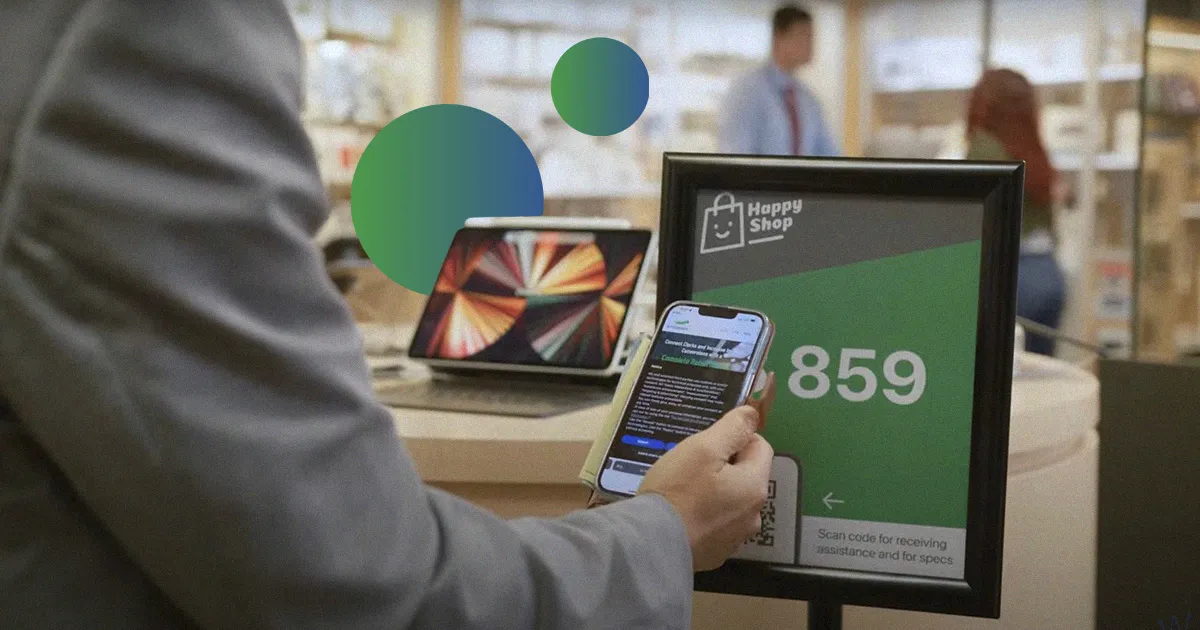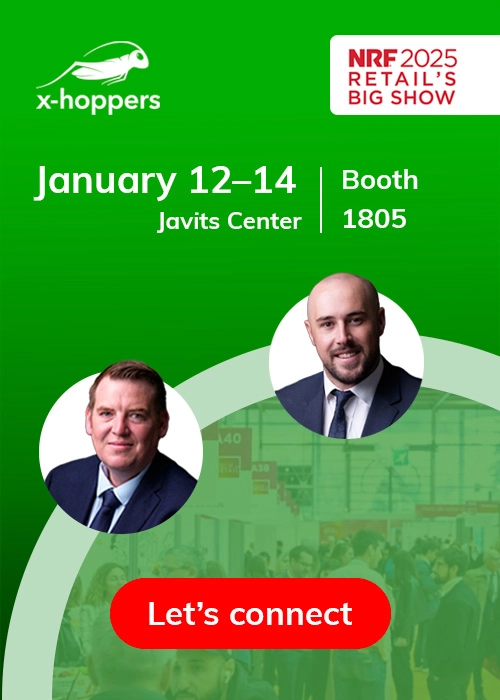
In an ideal world, customer-facing staff would always be visible and available to help. But the reality of running a store — let alone on a busy or low-staffed day — means that that’s far from the reality. There are always shelves to restock, messes to clean up and pricing to do that takes time and attention away from customers.
Traditional bells, whether placed on a counter or over a door, help somewhat, but they are very limited. The noise can also irritate customers and be missed by staff. Retail call buttons, especially when paired with headsets, bypass this problem by only sending the alert to staff members. And for stores that have only ever had bells, PA systems and walkie-talkies for in‑store communication, retail call buttons are a retail touchpoint that brings increased efficiency to store operations.
But the reality is that their functionality is not much more advanced than the bells they replace. With the rise of omnichannel shopping, phygital experiences and connected store ecosystems, store needs and functions are changing at lightning speed. Call buttons, sadly, aren’t. Instead, we’re seeing retailers ditch physical buttons for the next big leap in in‑store communication — smart call points that work by placing QR codes in retail stores.
Why You Should Use QR Codes in Retail Stores Instead of Retail Call Buttons
Let’s, for a second, imagine that you’re a customer looking to buy an electric drum kit. You could just order it online, but you really want to see the size of it, have a chance to test it and ask detailed questions about the product. You decide to go to a large store that carries a wide variety of instruments, even though it’s a fair distance to travel. Once you get there, you can easily see the drums, but finding a staff member is a different matter. After searching around for someone available, you eventually notice a small button in between the drums and guitars. Relieved, you press the call button and wait for an expert to come.
However, once the store associate arrives they admit they don’t know much about drums. Their specialty is guitars. So, you wait another five minutes for them to contact a colleague who can finally come out and give you the details you need to make an informed purchase. Or, worse, you’re told the drum specialist isn’t in and you need to either look online for the answers or come back another day. Which of course you don’t do, and you decide to shop with a competitor instead.
Now, imagine a different scenario where there’s a tag on the specific drum set you’re interested in. On it, there’s a QR code and a note that says “Need help? Scan the code below”. As soon as you scan the code, a notification pops up letting you know a sales associate is on their way, and you’re taken to the products webpage where you can see the price, product description and delivery options. Next thing you know the right help has arrived, and you’re given a complete overview of the product. You’re happy enough with the product that you order it right away and walk out of the store satisfied.
For such a drastically different experience, the only thing that the store needed to do differently was offer a more efficient and user-friendly call point. And that’s because as helpful as retail call buttons are, they are limited and don’t offer:
- Impressive flexibility
- Fast technical support
- Tracked and analyzed notifications
- Multifunctionality
That’s only available with smart call points.
Impressive flexibility
In a large store, using physical call buttons means that you need to purchase and maintain enough buttons to ensure that customers can get help anywhere in the store. Each button has an associated cost, so stores try to stretch buttons to cover multiple departments or areas, placing them where they aren’t blocking any displays or important products.
It’s a natural reaction, but unfortunately, this makes the buttons hard to locate or impossible to notice. Also, the larger the area covered, the less specific the prerecorded message can be. So other than a general idea of where the customer is waiting, store associates have no hint as to what the customer needs. And once they get to the customer, if they discover it’s something they aren’t authorized to help with, the customer has to wait even longer for another associate to come and assist.
Smart call points, on the other hand, offer true flexibility. Since they’re quickly created and easily printed onto rack labels, price tags, banners or any other printed media, QR codes in retail can be sprinkled across the shop floor and even placed on individual items. Changing them is also a breeze, making it easy to adjust to changing layouts and promotions. As a result, every time a QR code is scanned, frontline workers immediately know where the customer is, what the issue could be and who from the team is best suited to respond to the request, reducing wait times and increasing customer satisfaction.
The fact that they’re a printed solution, also means that maintenance costs are minimal. If a QR code in the retail industry is ripped or damaged, all you need to do is print another one. With a retail call button, you need an in‑store tech team, technology partner or the manufacturer to find the fault and fix it. This comes with a high price, not only because there may be a cost to repair it but also because the longer the button is down, the more likely you are to lose sales as customers can’t get the attention they deserve.
Fast technical support
Of course, a damaged physical call button or QR code isn’t the only thing that could go wrong with either solution. Problems with the interface between the call point and headsets can pop up and take time to troubleshoot. However, since it has no mechanical components, a QR code in a retail store will never need replacement parts to be purchased or to be serviced. If there’s something wrong with the code itself, all you need to do is generate a new code and the problem’s fixed. If you can’t do this yourself, either the vendor or your service provider can quickly generate one for you and send it over via email or even chat — no shipping or long wait required.
Also, since it is just a code, there’s no opportunity for the communication vendor to pass the blame onto a manufacturer or other third party. If there’s a serious problem with the setup, it’s clear who you need to contact to fix it. As a bonus, QR code-powered smart call points, like the ones used by x‑hoppers, are usually backed by a cloud-based communication system. That means that while there’s always a chance there could be a hardware problem somewhere, the issue is more likely to be one that can be fixed remotely.
Of course, if you do need tech support to come to the store, choosing a provider that offers local support is vital to ensuring you can get the system back up quickly with minimal disruption to your business.
Tracked and analyzed notifications
Most retail call buttons send out an alert when pressed and that’s it. So, if no one responds to the notification, it looks the same in a report as one that was answered, since the only thing recorded is how many times the button is pressed. And as anyone who has spent time around small children knows, buttons exist to be pressed. Sometimes again and again.
QR codes, on the other hand, need a smartphone to activate them. This discourages young children from overusing them, causing fewer false alarms. With some smart call points, in addition to registering the QR code scan the system also records the name of the store associate who responds. This way managers can track which store associates are engaging with the system and even analyze the departments or products they favor.
Retailers using QR codes can also track hot spots and customer behavior thanks to the fact that QR codes can be placed on any or all products. All of this data over time, can give stores the information they need to identify training opportunities and customer patterns.
As a result, the tempting design of retail call buttons and the lack of detailed analytics can give an incomplete picture of how the buttons work in context. Choosing to use a QR code in the retail industry for communication, jumps over these problems and provides a deeper insight into customer behavior.
Multifunctionality
If there’s one thing that makes retail call buttons look like an antiquated system, it’s the fact that they’re a one-trick pony. They send an alert. That’s it. They can make an audible noise or send a notification to a headset but at the end of the day, there’s nothing else they can do. With smart call points, you can use a QR code to send a notification and pull up a webpage at the same time, so that customers can discover more about the product while they wait. Or you can even set it up so that customers can start a chat, voice or video call from their device and talk to a sales assistant in store or off‑site.
And if you’re concerned that some of your customers won’t have access to a smartphone or don’t want to scan a QR code due to security concerns, you can add the same functionality to a kiosk or tablet. This setup works particularly well at order and collection points or next to products that require specialist advice, as they’re areas where customers regularly need support and are unlikely to change frequently. This system can even allow you to support small stores or stores with peak traffic by connecting customers to product specialists located in another retail unit or call center.
However, since retailers are already using QR codes for scheduling appointments, sharing menus and other services, the majority of customers are comfortable using them. It’s just a matter of listening to your shoppers and finding the combination of QR code-based and tablet-based smart call points that works for your store.
Smart Call Points: Part of a Complete Retail Communication System
As cool as QR code-based smart call points are, on their own, they’re just a bunch of pixels. To get the full benefit from them they need to be backed by a retail communication solution that allows shop assistants to collaborate, make and receive calls and respond to system and call point notifications from anywhere in store. While multiple providers combine headsets and retail call buttons, x‑hoppers is the only solution of its kind that includes headsets, smart call points, full telephony and tracking and analytics. With such a complete set of features, x‑hoppers goes beyond simply reducing employee step counts, helping retailers decrease training time, reduce shrink and increase sales.
But whatever system you choose, make sure you find one that is flexible and dynamic enough to keep up with your business and the ever-changing demands of modern retail. Because the last thing you want to do is be the store that relies on a bell when your customers expect a more efficient retail touchpoint and more personalized service.


